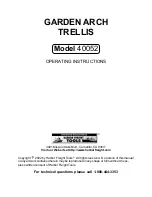
GB
3
TRAINING:
It is the responsibility of the users of this equipment to understand these instructions, and to be
trained in the correct installation, use, and maintenance of this equipment. These individuals must be aware of the
consequences of improper installation or use of this equipment. This user manual is not a substitute for a training
program. Training must be provided on a periodic basis to ensure proficiency of the users.
UsE:
The Twin-Leg TALON™ Self Retracting Lifeline (SRL) may be used to provide continuous fall protection while
ascending, descending, or moving laterally. The SRL is intended for use with fall arrest equipment in compliance with
EN 36.
The twin-leg talon srl is a “Y-type” 00% tie-off. With one lifeline attached to the anchor structure, the worker can
move to a new location, attach the second unused lifeline, and disconnect the original attached lifeline. This procedure
is repeated until the work location is reached. Other practices that must be followed in order to use an srl safely
include:
Connection of both lanyard lifelines to separate anchorage points is acceptable. (Figure )
Never connect more than one person to a “Y” type SRL at a time. (Figure 2)
Do not allow the lifelines to become tangled or twisted together as this may prevent them from retracting.
Do not allow any lifelines to pass under arms or between legs during use.If a fall occurs the employer must have a
rescue plan and the ability to implement a rescue.
Warning:
The anchorage structure must be capable of supporting a load of 22.2 kN (5,000 lbs.). Make only
compatible connections to anchors conforming to EN 795. Connect only to an overhead anchorage. Do not work
above the anchorage. (Figures 3 and 4)
INsTALLATION:
Attach the TALON™ SRL to the webbing at the crossover on the dorsal back plate of a full body harness (Figure 5)
(conforming to EN 36) as follows:
step 1.
Depress the locking lever (A) and pull out the pin (B) fully until it locks in the ‘out’ position. (Figure 6)
step 2.
Pass the handle (C) behind the harness web crossover, capturing both web straps in the same manner as the
dorsal D-ring. (Figure 7.)
important:
Make sure the metal handle of the SRL captures both web straps, not just one of the straps.
step 3.
Press the locking lever (A) to release the pin. Ensure the pin passes through the handle (C) on the Talon SRL
and the pin (B) is in the fully closed position. (Figure 6)
step 4.
Wrap the Hook and Loop straps around the harness webbing to minimize movement of the SRL while
working. (D). (Figure 8)
ENvIRONMENTAL hAzARds:
Use of this equipment in areas with environmental hazards may require additional
precautions to reduce the possibility of injury to the user or damage to the equipment. Hazards may include, but are
not limited to: heat, chemicals, corrosive environments, high voltage power lines, and sharp edges. Contact Capital
Safety if you have questions about using this equipment where environmental hazards exist.
MAINTENANCE:
Exterior:
Periodically clean the exterior of the SRL with water and a mild detergent. Position the SRL so water can
drain out. Clean labels as required.
Lifeline:
Clean the lifeline with water and a mild detergent. Rinse and thoroughly air dry. Do not force dry with
heat. An excessive buildup of dirt or other contaminants may prevent the lifeline from fully retracting, causing a
potential free fall hazard. Return the SRL to an authorized service center for lifeline replacement if necessary.
system components:
Clean and store associated system components according to manufacturer’s instructions.
Warning:
Do not disassemble the SRL. Do not lubricate any part of the SRL. Additional maintenance and servicing
must be performed by an authorized service center.
sTORAGE:
Store the SRL in a cool, dry, and clean environment, out of direct sunlight. Avoid storing the SRL in areas
where chemical vapors exist. Thoroughly inspect the SRL after extended storage.
INsPECTION:
(Figures 9 and 0)
Before each use,
visually inspect the SRL according to the following steps:
step 1.
Inspect the SRL for loose screws, bent or damaged parts.
step 2.
Inspect the housing for distortion, cracks, or other damage. Ensure the anchorage point is not damaged
or distorted.
•
•
•
•
•
•
•
•
Содержание DBI SALA KD1TALTWIN
Страница 2: ... 7 9 10 12 100 kg Maxi 11 8 D ...


































